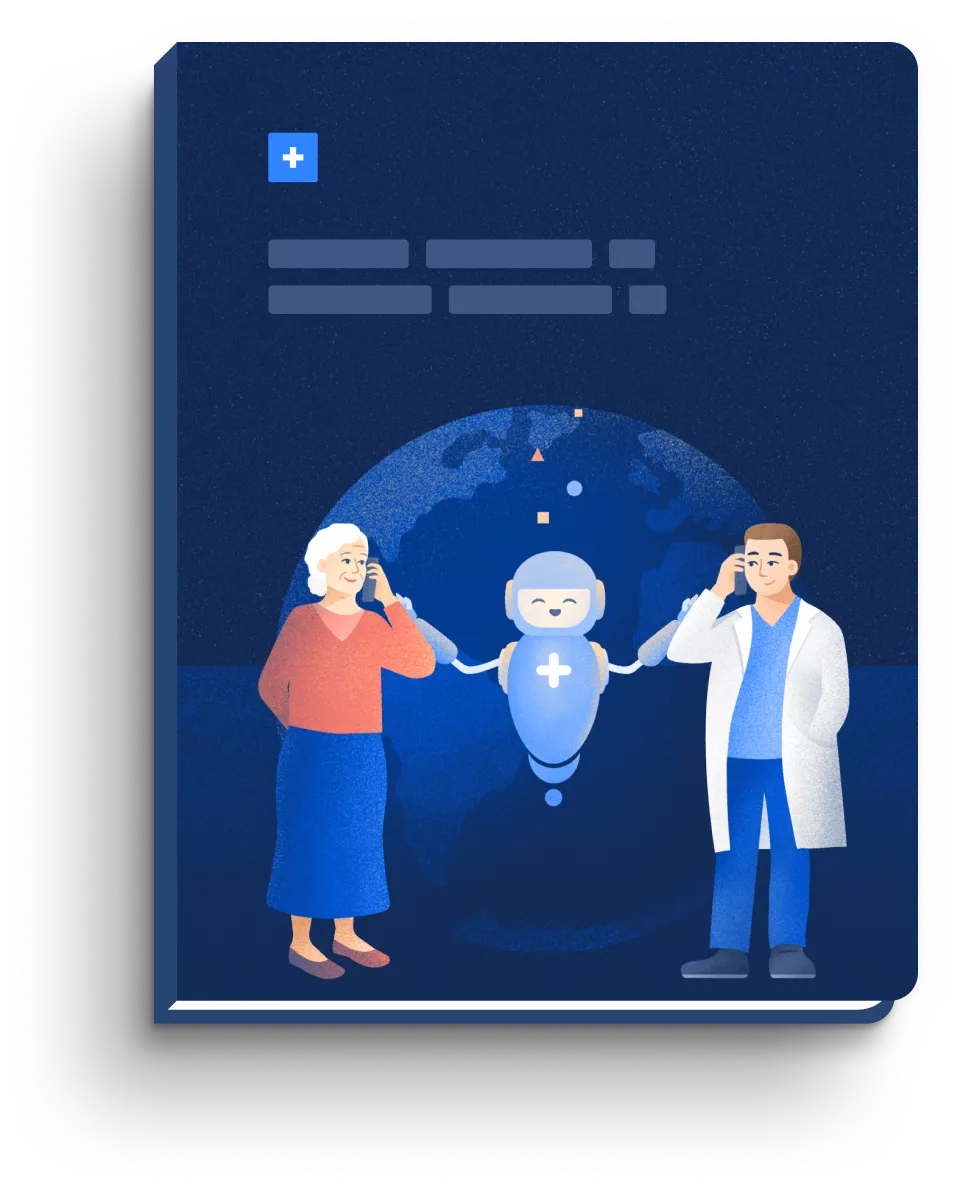
Artificial intelligence (AI) is the buzzword circulating in the news, on social media platforms, and at conferences worldwide across every industry. And the healthcare scene is no exception. At 2023 events, such as ViVE and HIMSS, the floor has been awash with AI chatter, excitement, predictions, and, of course, some hesitation and resistance. But, whatever your stance, the undeniable fact is that AI in healthcare has arrived — and it's here to stay.

Stepping into the future of healthcare with AI-driven solutions. Illustration by Magdalena Kościańska.
However, as excited conversations are currently spattered with elements of mistrust, it's clear that health tech organizations have a responsibility to strengthen confidence in this field. So what can we do to build trust in this rapidly expanding technology? How can companies prove AI’s worth and, more importantly, its reliability to both medical professionals and patients alike?
In this article, we outline 6 steps to combat the hesitancy and resistance felt among some providers and consumers, while remaining true and accurate regarding the expectations and limitations of AI in healthcare.
Trust. Trust is at the basis of every relationship: with each other, technology, establishments, and processes. We trust banks to keep our money, we trust factories to produce our goods, we trust pilots and aircraft manufacturers every time we board a plane. Without widespread trust, none of these industries would be able to exist. And it’s the same with healthcare.
Currently, we trust medical professionals to diagnose and treat illnesses, to perform surgeries, to advise us about preventative care, and to create treatment plans that benefit our overall health. However, with rapid advancements in AI, machine learning (ML), and large language models (LLM) many of these things that have previously relied solely on the skilled medical community can be supported by trusted digital technologies. And so, we must build trust to allow clinicians to be supported by AI and to acknowledge the numerous benefits of combining AI tech and healthcare — from improved access to healthcare to better patient outcomes and everything in between.

User’s trust in the use of artificial intelligence (AI) is essential for it to effectively contribute to the user experience and accelerate the adoption of AI platforms in the healthcare sector. There are three basic pillars that contribute to trust, which include investing in user information/literacy, clear information on how AI works, transparency, creating continuous and accessible communication channels for users to provide feedback, and the data protection/privacy, making it clear to the user how their data will be used by the AI. The application of these simple rules allows users to build the foundations of trust that over time will influence users' consumption habits and encourage continuous growth in the adoption of these technologies.
Chief Technology Officer, grupoGBI
Building trust in AI is the responsibility of all companies creating and utilizing AI-based solutions. This includes medtech businesses such as Infermedica, telemedicine companies, health systems, providers, and insurers. Here we outline 6 steps to fostering trust among patients and physicians.
Communicate clearly and honestly: Patients and physicians need to understand how AI technologies work, the benefits they provide, and their limitations. It’s important that healthcare organizations explain how an AI-driven solution arrives at its decisions and it’s equally important to show where it’s collecting its data from. It’s also vital that this explanation is in clear language that individuals who are not tech-savvy will be able to understand with ease.

Explore the potential of AI and telemedicine to revolutionize patient care and the benefits of their synergistic integration.
Demonstrate effectiveness: Organizations can reduce resistance to AI in healthcare by utilizing information gathered in reports, such as test cases, and providing data that demonstrates its effectiveness in improving patient outcomes, increasing organizational efficiency, reducing healthcare costs, and more. For example, one study has shown that 78% of medical staffers experienced workflow improvements with AI, while in another, the AI algorithm was able to accurately diagnose breast cancer from mammograms with a sensitivity of around 90%, which was comparable to that of human radiologists.

AI is no longer a futuristic notion confined to sci-fi movies nor a technology that's restricted to high-income countries. AI is improving access to healthcare, in our case it enables rapid and accurate assessment of patient's conditions, helping healthcare providers prioritize and guide cases based on severity.
Healthcare Innovation Manager, Ultravioleta HealthTech
Emphasize safety and address privacy concerns: Before being put into practice, AI technologies must be thoroughly tested to ensure they are safe for use. These tests, evaluations, and findings should be shared with physicians and patients to build confidence in AI’s capabilities and also to highlight any limitations that still exist. According to one survey, 52% of business leaders in the healthcare industry reported having concerns that AI in healthcare could lead to threats to security and privacy. Therefore, organizations must also show their technology's compliance with regulatory standards such as GDPR and HIPAA for data protection and privacy, and ISO accreditations for regulated medical devices.

Building trust in healthcare was always challenging and now, more than ever, we know how important it is to deliver the highest treatment outcomes to patients. Yet, the huge medical needs of the population, the shortage of medical healthcare professionals, and a lack of time to talk peacefully and assist patients during the appointment, don't help in this area. On top of that, each individual medical professional attitude can make a significant difference in both directions.
People in need always seek understanding and empathy while expressing their health problems. How can we at Infermedica help? Besides the fact that our medical teams have spent over 84,000 hours producing a medical knowledge base of the highest quality, we also eagerly reap the benefits of AI technology to provide solutions where patients can express themselves accurately and with peace of mind. They don't have to be in a hurry ever again, they can focus on their problems and answer with confidence to get the most accurate results possible and so the medical professionals in charge can make the best of it during the visit.
We believe that combining constant proximity to the patients with offering up the highest quality product fulfills our great mission to make healthcare accessible to everyone in need.
Pediatric Surgeon & Head of Clinical Validation, Infermedica
Highlight patient experiences: Show, via reports and patient testimonials, the real-life impact that AI-driven technology is having on the patient experience and patient outcomes. For instance, a recent report found that participants preferred chatbot responses to physicians' responses in 78.6% of cases. The study concluded that AI-based chatbots often gave answers superior in quality and empathy to those of physicians. Highlighting data found in reports such as these, and sharing real-life user stories, such as the one displayed in the graphic below from Infermedica's AI-powered Symptomate tool, can go a long way to showcasing the benefits of AI to patients and providers.

About a year ago, I started feeling like my well-being was beginning to worsen. I often had a headache; I lacked strength, was sleepy, and had problems getting up in the morning. Although these symptoms were quite bothersome, at the same time, they were pretty vague. That's why I didn't take any steps for a long time.
However, at some point, everything intensified to such an extent that it began to hinder my functioning seriously.
At that time, my husband showed me the Symptomate app. Without much expectation, I entered all my symptoms. Among the possible diseases mentioned, Hashimoto disease appeared. It surprised me because I hadn't considered thyroid problems before. After a series of tests in the laboratory, the diagnosis was precise: Hashimoto's disease. Symptomate was right.
Anonymous female
via direct conversation
Provide adequate training: With the introduction of any new technology, training is important. In healthcare, it is vital. Physicians need to understand how to use evolving digital solutions effectively and to be assured that these technologies will make their lives easier, not more difficult. In addition, organizations must advise patients on the best way to interact with such technologies, including the effective use of symptom checkers, wearables, virtual consultations, and more. A 2023 study of physicians and medical students found that 82% of the participants agreed that with dedicated courses and workshops, they can start implementing AI in their practice.

AI is a tool to assist healthcare providers rather than replace them. AI recommendations are used to support the decision-making process, which is headed by physicians, and ultimately empower patients.
Healthcare Innovation Manager, Ultravioleta HealthTech
Maintain human touch: In a recent study, 57% of respondents believed using AI for diagnosing diseases and recommending treatments would worsen the patient-provider relationship. To combat such widespread sentiment among consumers and providers, healthcare organizations need to be transparent about their use of AI and ensure patients and physicians understand that AI technologies are there to supplement human care, not to replace it.
Healthcare organizations, including telemedicine companies, healthcare providers, and insurers, have to start building trust among patients and the medical community. This will be done via open and transparent communication about their technologies, the extent to which AI is being used, and the limitations and risks associated with such technology.

At Infermedica, we pride ourselves on honest and accurate communication. Every partner, client, and consumer is a valued part of our mission to make healthcare accessible, accurate, and convenient for all. Safety and trust are our top priorities, and as we continue to advance in this exciting new world of healthcare technology, we're committed to ensuring the accuracy and safety of our AI-driven digital solutions.
CEO & Founder, Infermedica
Nothing will replace the people at the center of care delivery, but intelligent platforms are transforming the patient experience, supporting burned-out providers, and stabilizing a fractured global healthcare system still recovering from a global pandemic.
We believe that trust is essential — between everyone involved in healthcare.
The original version of this page was published at: https://infermedica.com/blog/articles/navigating-the-intersection-of-trust-ai-and-healthcare
Infermedica's mission is to make healthcare accessible, convenient, and affordable for everyone worldwide, by automating primary care from symptom to outcome. The company develops a Medical Guidan... Read more
Emergency departments (EDs) are often overcrowded, leading to long wait times and a decrease in the quality of care for patients. However, 67% of ED visits are considered avoidable. ...read more
NOTE: This article was published in September 2023. Commentary on the status of legislation is accurate at the time of writing.No doubt about it, Artificial intelligence (AI) is bursting ...read more
An effective digital front door needs to be much more than just the entry point into the system. Consider the front door of an office building—it is not only an entrance ...read more
We often hear that digital health solutions are for everyone. That said, is it true? In this article, we’ll cover what digital accessibility is, why it matters in healthcare, ...read more